The Google Nexus 7 tablet by Asus is here, and it’s flying off of the shelves, but how does it hold up to the already popular Kindle Fire, which has dominated the 7 inch tablet market at this price range for a while now?
Let’s take a look at them and see which is better for your money.
1. Side By Side Comparison
At first glance, they look fairly similar. Nearly the same dimensions, crisp looking screens. The Nexus is a little lighter weighing in at 12 ounces, compared to the Kindle Fire at 14.6 ounces.
Holding one in each hand, you’ll notice how much how much slimmer the Nexus 7 feels compared to the Kindle Fire. It’s only .95 millimeters thinner at 10.45mm compared to 11.4mm on the Fire, however the Nexus 7 has nice rounded edges which feels nice cradled in your hand, compared to the somewhat square edges on the Fire. Not a big deal to most people, but comfort can tip the scales when it comes to tablets.
The Kindle Fire has one button, which is the power button, placed oddly at the bottom. Since there are no volume rockers, you have to change the volume on the screen. The Nexus 7 has a larger power button on the right side near the top, with volume rockers about a quarter inch below.
2. Comparing Stats and Features
They boast a lot of the same stats, like built in Wi-Fi, 8 gig hard drive (16 gig option available on the Nexus 7 for an additional $50), 8 hour average battery life, free cloud storage by their respective providers. They each have a micro-usb slot, and 3.5 mm headphone jacks.
Where the Nexus 7 starts to take a big lead is in hardware stats. The Nexus 7 boasts a quad-core Tegra 3 processor, compared to the dual-core ARM processor. This means a lot less lag and hiccups on the Nexus 7 for sure.
The Nexus 7 also has a 1280×800 HD display, showing 216 pixels per inch (ppi), while the Kindle Fire has a resolution of 1024×600, with 169 ppi. More pixels per inch is always good, leading to a more crisp screen showing more detail.
The Nexus 7 also comes with several things that the Kindle Fire doesn’t have, like built in GPS, and a front facing camera. The camera is only 1.2 megapixels, but allows for things like face recognition security, and automatic on/off features when a case is attached, etc.
3. Comparing The Operating Systems
The Kindle Fire runs a version of the Android OS, but it’s heavily skinned by Amazon limiting a lot of functionality. Your “home” screen is the Kindle E-Reader, which is fine if that’s all you’re interested in, but if you’re wanting a fully functional tablet, then the Kindle Fire may not fulfill your needs. You can get a lot of the apps that you can get on most Android devices, but you may find that some of your favorite games and apps aren’t available.
The Nexus 7 runs the latest version of the Android OS (as of this article being written anway) named Jelly Bean. It’s not skinned either, it’s the full blown Android OS with full access the Google Play market.
Personally, I like having access to my email widgets, calendars, home screens, etc. The only way to get that type of functionality on the Kindle Fire is to root it and put something like the Cyanogen Mod on it, if you’re techy enough to do that.
Final Thoughts
Since both of these tablets are $199 (for the 8 gig model anyway), I think the clear winner here is the Google Nexus 7. It’s a real functional tablet, while the Kindle Fire is essentially an e-reader with a little more function.
The Kindle Fire is an older device though, so I wasn’t surprised that the Nexus 7 beats it on stats, however I think they will have to reduce the price on the Kindle Fire in order to compete.
I’m sure there is already something in the works from Amazon to be able to compete with the Nexus 7, but at the moment the Kindle Fire seems to be on the way out, and the Nexus 7 is on the way in, very quickly.

